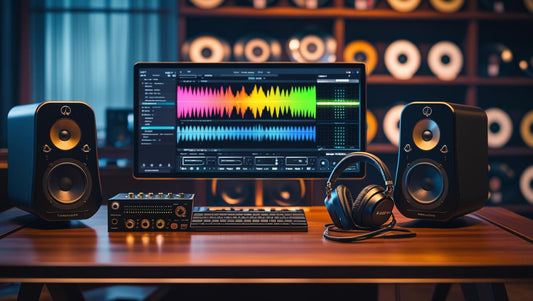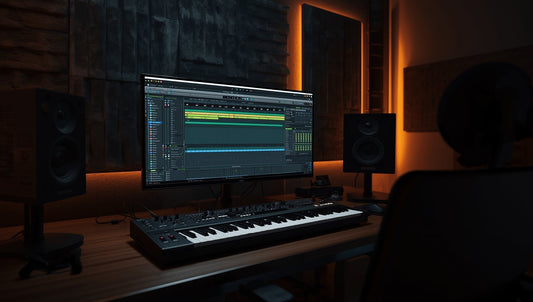How to Mix and Master a Song with Analog Character

Mixing and mastering aren’t just technical steps in the music-making process — they’re what make your track feel finished. It’s where emotion, groove, and energy all come into focus. You’re not just leveling sounds , you’re telling the story of your track, making sure it translates with clarity and intention whether it’s playing on headphones, car speakers, or a vintage vinyl setup.
A good mix doesn’t just sound clean — it feels right. It captures the vibe of the genre and delivers it with punch, depth, and character.
The Importance of Analog Character
In the age of ultra-clean digital production, too many tracks lose the soul that made older records unforgettable. Analog-style mixing brings that back — with subtle saturation, warmth, tape-style compression, and textured EQ shaping. It’s the glue that holds everything together.
For genres like boom bap, lo-fi, neo-soul, or underground trap, analog warmth isn’t optional — it’s the secret sauce. It makes drums hit deeper, vocals feel more present, and melodies glide like they’re coming from a dusty sampler or SP1200 rig.
What Is Mixing vs. Mastering?
Before diving into analog techniques, it’s important to understand the difference between mixing and mastering — two distinct but deeply connected stages in music production. Each plays a critical role in shaping your final sound.
Understanding Mixing
Mixing is where the magic begins. It’s the process of combining all your individual tracks — drums, bass, melodies, vocals, effects, into a single, cohesive stereo experience.
In this stage, your job is to:
-
Balance volumes across all elements
-
Pan sounds across the stereo field for space and clarity
-
Shape tone using EQ and compression
-
Add effects like reverb, delay, or saturation to enhance feel
Mixing is where you build the vibe, guide the listener's ear, and give your song its emotional shape.
Understanding Mastering
Once the mix feels locked in, mastering is the final polish. It’s a separate step — usually done on the fully mixed stereo file, that ensures your track sounds consistent and impactful everywhere.
In mastering, the goal is to:
-
Finalize loudness so the track competes sonically
-
Apply stereo widening and tonal balance adjustments
-
Add subtle saturation or harmonic enhancement
-
Control peaks with limiting — without crushing dynamics
-
Ensure translation across headphones, car systems, streaming platforms, etc.
Mastering isn’t about making huge changes, it’s about making your song sound like a record.

Mixing with Analog Warmth
Achieving an analog feel in your mix doesn’t require vintage hardware — it starts with how you organize and approach the process. Analog warmth is about vibe, texture, and balance. Here's how to shape your mix from the ground up.
Step 1 – Organize and Import Tracks
Before you touch a fader or dial in any effects, get your session clean and structured. This makes a world of difference in how smoothly your mix flows.
-
Group similar elements: drums, melodies, bass, vocals, FX
-
Label tracks clearly to avoid second-guessing
-
Use color coding in your DAW to spot elements at a glance
A clean session = a clear mind. You’ll mix faster and make better decisions.
Step 2 – Establish the Anchor (Kick, Snare, or Vocal)
Every mix needs a center of gravity — a sound that grounds everything else. In boom bap or trap, it’s usually the kick or snare. In lo-fi or soul-based tracks, it might be the vocal or main melody.
-
Choose one element that sets the emotional and dynamic tone
-
Mix around it — let other instruments support, not compete with it
This step helps you preserve the feel of the track instead of chasing perfection.
Step 3 – Volume Balancing
Now that everything’s in place, it’s time to move the faders. Your goal isn’t loudness — it’s clarity and relationship between parts.
-
Set rough levels for each element
-
Make sure drums knock, bass holds the low end, vocals ride above the mix
-
Don’t solo too often — balance while hearing everything together
This is where your mix starts to breathe.
Step 4 – Panning for Space
Analog warmth isn’t just tone — it’s depth. And smart panning creates width that feels natural.
-
Keep kick, bass, snare, and lead vocals in the center
-
Pan melodies, backing vocals, FX, and percussion for stereo width
-
Don’t overdo it — subtle moves often sound more musical
A well-planned mix gives your track that vintage sense of space, like a live session on tape.
Using EQ to Carve Space
Why EQ is Crucial in an Analog-Sounding Mix
EQ isn’t just about fixing problems — it’s about shaping tone. In analog-style mixing, the goal isn’t precision surgery — it’s subtle sculpting that brings out character and warmth.
Digital EQ can sometimes feel harsh or clinical. Analog-inspired EQ, on the other hand, enhances a sound’s natural feel, letting each element sit where it belongs without sounding forced.
Tips for an Analog EQ Approach
-
Roll off low-end on non-bass instruments to leave space for kicks and subs
-
Boost upper mids gently (2k–5k) to bring vocals forward without sounding harsh
-
Use broad curves, not narrow spikes — think smooth tone shaping, not forensic repair
-
Trust your ears, not the analyzer — analog sound is felt more than measured
This approach is especially effective when you're working with pre-processed kits like those from 12 Bit Soul — they already carry that vintage EQ character, so your job becomes enhancement, not correction.
Compression Techniques for Groove and Glue
Using Compression for Dynamics Control
Compression is more than volume control — it's a feel shaper. A good compressor can make drums hit harder, vocals sit tighter, and the whole mix feel cohesive without sounding squashed.
With analog-style compression, the aim is movement, not perfection. Let the groove breathe.
Analog Compression Tips
-
Slow attack, medium release: Let transients punch through before taming them
-
Parallel compression: Blend a compressed signal underneath your dry drums or vocals to add body without losing dynamics
-
Bus compression: Apply gentle compression across drum or melody groups to add cohesion (think of it like gluing everything together)
-
Avoid crushing the life out — leave some bounce, especially in genres like lo-fi or boom bap
Compression should feel like it’s hugging the mix, not flattening it. When dialed in right, your track sounds louder, fuller, and more emotionally connected — without ever clipping or fatiguing the ear.
Here’s your next section for the blog “How to Mix and Master a Song with Analog Character” — presented in a polished, easy-to-digest format that blends guidance with brand tone and a bit of storytelling flair.
Adding Analog Saturation and Harmonics
What Is Saturation in Mixing?
Saturation is where digital meets human. It’s the subtle magic that adds warmth, harmonics, and character to your sound — the kind you feel more than hear.
Originally, saturation came from tape machines and tube gear, which colored audio in pleasing, musical ways. In the analog world, pushing a signal slightly too hard added richness — not harshness. That’s what modern producers now emulate digitally.
Natural Integration of Saturation
You don’t need to saturate every track. In fact, one of the most analog things you can do is use it with intention.
-
Add gentle saturation to the drum bus to enhance transients and glue
-
Use it on synth or melody groups to warm them up without dulling the mix
-
Apply it subtly across the entire mix bus for a cohesive, analog glow
Use tools like the AMPlify Plug-In to create that 90s-inspired, SP1200-style grit — perfect for making drums or vocals cut through without sounding artificial.
Example Callout:
“We used AMPlify to make the snare from Soul Vol. 4 punch through the mix — then used it with vintage-style compression to lock it in.”
Mastering with Analog Vibe
Mastering is your track’s final transformation — it’s where you take a great mix and prepare it for the world. Keeping it analog-feeling means preserving vibe while adding clarity, warmth, and competitive loudness.
Preparing Your Track for Mastering
-
Export your final mix at -6 dB headroom
-
Remove any limiting or compression on the master bus — keep it clean
-
Render to a 24-bit WAV file for best quality
Mastering Chain Essentials
A simple chain can deliver serious results:
-
EQ – For subtle tone shaping (not fixing)
-
Saturation – A touch of analog warmth to enhance character
-
Compression – Light glue to hold it all together
-
Limiter – Raise loudness to streaming levels without flattening dynamics
This chain keeps your music sounding full, warm, and balanced — not overly squashed or digital.
Reference Across Devices
Once you’ve finished your master, it’s time for the truth test:
-
Play it on headphones, laptop speakers, car stereo, and phone
-
Listen for tonal imbalance, harshness, or muddiness
-
Make small adjustments and repeat until it translates cleanly across every system
Analog mastering isn’t about being loud — it’s about sounding right everywhere.
Bonus Tips for Vintage Sound
Use Analog-Processed Sound Kits
If you want your mix to start with warmth, choose the right ingredients from the beginning. Kits like SP1200 Fusion are designed to bring that classic hardware sound straight into your DAW — no extra plugins or processing required.
-
These kits come pre-saturated, EQ’d, and textured, so you don’t need to fake the vibe — it’s already there.
-
Ideal for lo-fi, boom bap, soul, and trap where tone and feel matter more than clinical precision.
When your drums already hit like a record, your mix becomes about enhancing, not fixing.
Don’t Over-Mix
Analog character is about letting imperfections breathe. If everything is too clean or too processed, the soul of the track gets lost.
-
Leave space. Let air between instruments exist.
-
Don’t fix what isn’t broken — vibe often lives in the rough edges.
-
Avoid over-compression or EQ abuse — subtle moves go further when your sounds are well-chosen.
Analog warmth thrives on texture, movement, and restraint.
Final Thoughts
Why Feel Matters Most
A technically perfect mix can still feel flat. What cuts through is emotion — the punch of the snare, the breath in the vocal, the swing of the rhythm.
-
Analog-style mixing doesn’t chase perfection. It chases the vibe.
-
When done right, it translates energy, tone, and attitude — not just loudness.
Whether you’re aiming for that 90s boom bap feel or a modern lo-fi blend, it all comes down to movement and intention.
Kits That Help You Get There
If you want to skip the over-processing and get straight to the sound, start with the right tools:
-
12 Bit Soul Vol. 1–8 – raw, textured, soulful drums
-
SP1200 Fusion – gritty, hardware-emulated tones
-
AMPlify Plug-In – for adding that analog glue without overcooking the mix
These tools aren’t just sounds — they’re shortcuts to emotion and vibe.
Want to capture the grit and groove of 90s golden-era production?
Start your next mix with analog-processed kits and tone tools from 12bitsoul.com.
FAQs
What is the best way to mix a song for analog warmth?
Start with textured sound kits, apply light saturation, use broad EQ curves, and avoid over-compression. Keep it musical, not mechanical.
Can you mix and master a song using only a DAW?
Absolutely. With the right approach and plugins (like AMPlify), you can achieve analog character 100% in-the-box.
Should I mix and master my own songs as a beginner?
Yes — it’s the best way to learn. Start simple, use reference tracks, and don’t chase perfection. Feel > precision.
How can I make my digital mixes sound more analog?
Use saturation, parallel compression, pre-processed kits, and trust your ears over visual meters. Focus on warmth, not brightness.
What’s the biggest mistake producers make when mixing?
Overdoing it. Too many plugins, too much EQ, too much compression. Sometimes, less really is more.
No comments








0 comments